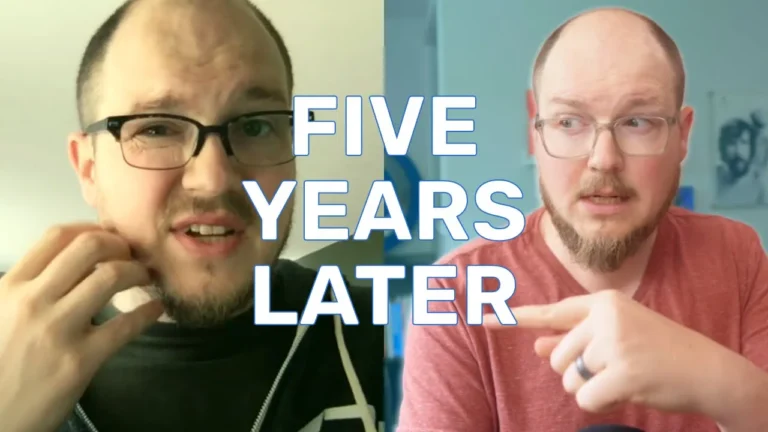A metaphorical tailspin
Somedays you’re on cloud nine, and somedays you’re plummeting through the atmosphere in an uncontrollable death spiral.
Don’t ask me why, but recently I was watching a video about how to recover from a tail spin. As in, you’re a pilot flying a plane and you stall out and start spiraling to your doom. I’m working on writing some curriculum for an upcoming coaching session, during which I planned to describe a downward spiral situation. I wanted to use the word “tailspin,” but I want to make sure that I’m using the term properly and understand what causes it.
During my Googlings, I stumbled upon a video of a flight instructor explaining a method to help pilots stay focused and work through all the steps they need to pull themselves out of a spin. It was really interesting in its own right, and being the classically trained analogizer and metaphorist I am, I thought there’s a wonderful illustration here. This method can actually help us recover from situations where we feel like we’re spinning out of control (and it happens from time to time – especially when you are running a business while juggling the rest of life’s stresses).
Whether it’s a team conflict where people just stop working together and start working against each other, or maybe it’s something that’s happening in your own life and you feel like everything is collapsing around you. Whatever the situation may be, let’s pull on our flight hats and walk through the P.A.R.E.D. method for tailspin recovery and start regaining some altitude.
Power
P is for power. The very first thing you want to do is power back. Reduce your speed. Otherwise, if you’re running your engine hot, you’re just heading towards the ground even faster.
Slow down. Whatever you’re going through, you need to destress and deescalate. Going through the rest of the situation hot-headed is not going to help. It is cliche, but take a deep breath, remember the recovery procedure, and commit to the next step.
Ailerons
A is for aileron. Ailerons are the outside flaps on the back of a wing. When they go up and down, it controls the roll of the airplane, lifting the wings up and down. If you’re spinning or rolling, that probably means one of the ailerons is engaged.
During these stressful situations, there’s usually another party involved – there’s another “wing” – and the two of you are out of balance.
Another department just sent another urgent request across. Even after you’ve told them time and time again you need at least five days advanced.
You find out that a teammate didn’t actually complete the task you were counting on them to do, and now you’re left picking up after them.
Maybe somebody is acting just plain nasty. They have something going on in their lives, and they’re taking it out on you.
Your instinct is to push back; lash back; jam the control stick in the other direction, and try to start rolling the other way. But that isn’t going to help. If you’re spinning, one of the wings has stalled out. If you try to reverse the ailerons, that’s just going to put more load on the wing, and it can’t handle that right now.
If you take a retaliatory action, you’re just putting more stress and more load on somebody who’s already stressed out. And they’re not going to respond and work with you very well. What you should do instead is neutralize the ailerons. Set them flat. Don’t swing back in the other direction and clock the other guy (as much as you want to), because that’s just going to keep you spiraling.
Now there is an adjustment involved at this stage. If one of the flaps is up or down, you need to set it straight. You can provide a slight corrective, and then let time and aerodynamics work for you and you’ll come out of that roll.
So now you’re not rolling around upside down, but you are spinning towards the ground in a downward spiral. So let’s move on to the next step.
Rudder
R is for rudder. Just like in a boat, on the back of the plane, you have a rudder. When you turn this rudder left or right, the nose of the plane turns in the opposite position. Now that you’re not spinning around, upside down in a tizzy, you can see where you’re at and understand where you need to head.
If you’re turning to the left, you want to turn back to the right until you’re straightened out and back on course. If there’s one or more other people involved, you can start speaking into the situation and course correcting, providing a direction for you to head together. Make sure that you’re not just spinning around in circles and not getting anywhere.
If you are working through some stress and anxiety that’s got you spiraling, try to remember: who you are, what your goals are, and where you’re headed in life.
The stress and discouragement and the disorientation is real, but it’s temporary. However far off course you may have fallen, you can start steering yourself back to where you want to be.
But don’t rush and try to make up for lost time just yet.
Elevator
E is for elevator – the flaps on the small rear wing of the plane that move the plane up and down. At this point, you’re still descending and you’re probably tempted to pull back on the stick and try to climb out of this fall as quickly as you can.
The problem is, we’ve lost so much power and momentum while we were spinning around, if we climb too high too fast, we’re just going to stall again.
You’ve experienced a setback; you’ve lost productivity. Your kids had to take an extra rest stop than you accommodated for in your itinerary. Your temptation is to floor it so you can catch back up and make up for lost time. But that’s introducing a lot of extra stress on your system that you’re not ready to handle right now.
You just went through something big. You were staring death in the face: The death of a group relationship, the death of a project, the death of your own ambitions. Don’t try to climb out of that too fast. In fact, keep your nose down for a little longer until you get your speed back up.
Recover from Dive
D stands for dive. Actually, it’s “recover from dive,” so technically the method should be called P.A.R.E.RFD.
If you’ve followed the previous steps, you’ve taken yourself out of a deadly downward spiral. You’re still descending, but you’re regaining momentum. Now you can begin to power back up and slowly climb back and try to achieve some normalcy again.
Conclusion
This situation will have caused a slight delay. You might not get to the gate at your original ETA and your passengers might need to change their flights. But it’s okay. Because you’re alive, and you’re getting home safe.
Being an entrepreneur; being fulltime selfemployed is really fun. There’s a lot of freedom. It feels like you’re flying sometimes. But that can put you in very stressful situations, especially when you’re the one behind the controls and you don’t have a safety net. You’re going to hit some turbulence occasionally, and every now and then, there might be a full-on system failure.
I’m very happy I stumbled upon this flight training video. I think it’s a brilliant illustration and a really helpful framework to help us keep our cool when we enter a stressful situation. It helps to have a process to go through methodically some steps to help us get back on course and not just keep spiraling out of control.
I hope this was helpful. Be careful out there as you build your business and set out to achieve some amazing things. Don’t hesitate to ask for help. Self-employment should not be by-yourself-employment.
If there’s anything I can do to help you along your self-employment journey, feel free to reach out to me at selfemploymentsidekick.com. And if you wouldn’t mind, please consider supporting this site and YouTube channel in some small way by liking, subscribing, and leaving a comment below just to say hi. That helps boost this video and this blog, and gets these resources in front of more business heroes just like you.


